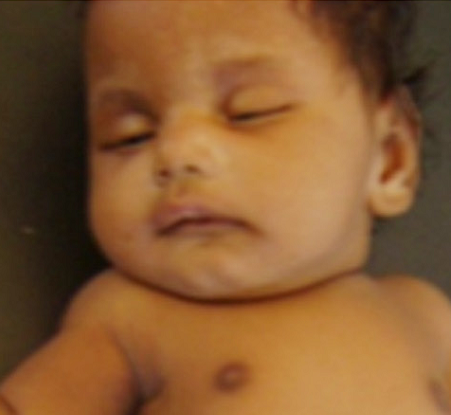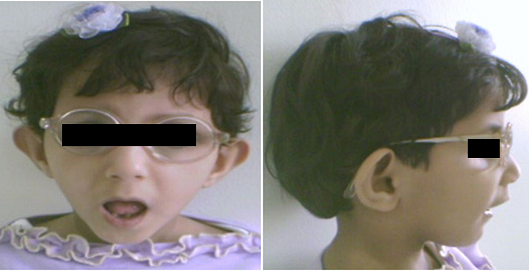Sanjad-Sakati syndrome (SSS)
Sanjad-Sakati syndrome occurs exclusively or almost exclusively in Arab people. Although exceedingly rare in most places, it is relatively common in the Gulf States, Saudi Arabia, and nearby areas. Its incidence in that region has been estimated at 1 birth per 40,000 to 100,000 in Saudi Arabia (1) and 7-18 births per 100,000 (1 in 5,600 to 14,000) in Kuwait (2). One study diagnosed SSS in a Hindu family from India; however, the diagnosis was not confirmed by gene sequencing (3).
Sanjad-Sakati syndrome is also called hypoparathyroidism-retardation-dysmorphism syndrome (HRD). Because the term Sanjad-Sakati is used most often, we have chosen to use this name here. SSS is very similar to Kenny-Caffey syndrome, type 1. Both are caused by mutations in the same gene and they share sufficient symptoms that we are also treating them as the same condition. The National Association for Rare Disorders (NORD) also classifies them as the same disease. Readers may wish to read a review of cases labeled SSS and/or KCS1 (2).
Clinical information
SSS is a relatively severe disorder that causes seizures, growth failure, failure to thrive, and intellectual disabilities. Like the similar condition Kenny-Caffey syndrome, type 2 (KCS2), SSS causes hypoparathyroidism (low levels of parathyroid hormone). Parathyroid hormone is important for regulating the levels of calcium and phosphorus in the blood. Patients experiencing hypoparathyroidism may feel tingling in their fingers, toes, or lips, and have muscle cramps and/or muscle spasms. They may also feel weak or nervous, have headaches, and/or memory loss. See the link at the right for more information about hypoparathyroidism.
Hypoparathyroidism typically causes hypocalcemia (low blood calcium). This problem is generally persistent in SSS patients (it is transient in KCS2 patients; 2). This distinction may be helpful for diagnosis (see section on Diagnosis and Testing below and reference 2). Other medical problems that occur in SSS are as follows:
- Microcephaly (small head)
- Delayed bone age
- Small hands and/or feet
- Short or very short stature
- Low birthweight
- Failure to thrive
- Low blood calcium
- High blood phosphorus
- Kidney calcifications
- Seizures (often beginning in infancy)
- Intellectual disability
Common problems in Sanjad-Sakati syndrome
In addition, SSS patients often share a similar facial appearance, with characteristics as follows:
- Micrognathia (small jaw)
- Microphthalmia (small eyes)
- Deep-set eyes
- Blue sclera
- Low-set ears
- Large forehead
- Beaked or sharp nose
- Long philtrum (groove below the nose)
- Thin lips
- External ear abnormalities
- Depressed nasal bridge
Facial features in Sanjad-Sakati syndrome
SSS is an autosomal recessive disorder caused by mutations in the gene TBCE. Autosomal recessive means that the syndrome occurs when both parents carry a mutated copy of a gene, and each passes the mutated gene to a child. The syndrome should be suspected in any very small infant presenting with seizures and hypoparathyroidism, particularly if the infant is of Arab descent. The link at the right provides a search for labs that test for Sanjad-Sakati syndrome; when this page was written, the search did not appear to work correctly. We searched for "kenny caffey type 1" instead.
The differential diagnosis for SSS includes Kenny-Caffey syndrome, type 2 (KCS2). Unlike SSS, KCS2 does not generally affect intelligence. Another important difference between the two syndromes is that children with SSS tend to have microephaly (very small heads), whereas KCS2 patients do not. KCS2 is also an autosomal dominant disorder, meaning that the syndrome can be passed from one affected parent to a child. KCS2 can also occur sporadically, which means that it is unlikely that siblings would be affected if a parent is not also affected. SSS patients may have affected siblings but, because of the severe nature of the syndrome, will almost certainly not have affected parents. SSS is caused by mutations in the gene TBCE. KCS2 and SSS share hypoparathyroidism and abnormal levels of calcium/phosphate in the blood; these conditions tend to be persistent in SSS and transient in KCS2.
Hypoparathyroidism is a rare condition and is an important part of KCS2. It is advisable to look for skeletal signs of KCS2 in very short patient diagnosed with hypoparathyroidism.
References
- 1. Franceschini P et al. (1002) Kenny-Caffey syndrome in two sibs born to consanguineous parents: evidence for an autosomal recessive variant. Am J Hum Genet 42(1):112-116. Abstract on PubMed.
- 2. Naguib KK et al. (2009) Sanjad-Sakati syndrome/Kenny-Caffey syndrome type 1: a study of 21 cases in Kuwait. E Med Health J 15(2):345-352. Full text from the WHO.
- 3. Kumar KJ et al. (2013) Hypoparathyroidism-retardation-dysmorphism syndrome. Ind J Hum Genet 19(3):363-365. Full text on PubMed.
- 4. Elhassanien AF et al. (2013) Neurological manifestations in children with Sanjad-Sakati syndrome. Int J Gen Med 6:393-398. Full text on PubMed.



